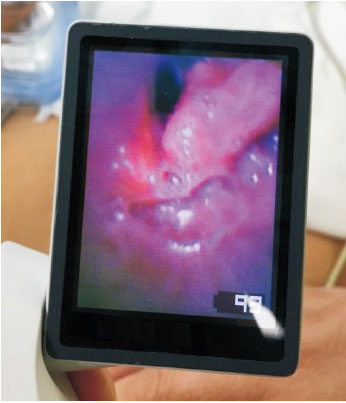Ewha Med J.
2018 Oct;41(4):86-89. 10.12771/emj.2018.41.4.86.
Endotracheal Intubation Using McGrath Videolaryngoscope in Klippel-Feil Syndrome
- Affiliations
-
- 1Department of Anesthesiology and Pain Medicine, Ewha Womans University College of Medicine, Seoul, Korea. jheewoo@ewha.ac.kr
- KMID: 2423792
- DOI: http://doi.org/10.12771/emj.2018.41.4.86
Abstract
- Patients with Klippel-Feil syndrome require much attention during anesthesia because of congenital abnormalities in head and neck regions and the high probability of neurological damage from cervical spine instability during endotracheal intubation. We report a case of successful endotracheal intubation using a videolaryngoscope in a patient with Klippel-Feil syndrome who experienced difficult transnasal intubation.
Keyword
MeSH Terms
Figure
Reference
-
1. Samartzis DD, Herman J, Lubicky JP, Shen FH. Classification of congenitally fused cervical patterns in Klippel-Feil patients: epidemiology and role in the development of cervical spine-related symptoms. Spine (Phila Pa 1976). 2006; 31:E798–E804.2. Harley EH, Collins MD. Neurologic sequelae secondary to atlantoaxial instability in Down syndrome. Implications in otolaryngologic surgery. Arch Otolaryngol Head Neck Surg. 1994; 120:159–165.
Article3. Lennarson PJ, Smith DW, Sawin PD, Todd MM, Sato Y, Traynelis VC. Cervical spinal motion during intubation: efficacy of stabilization maneuvers in the setting of complete segmental instability. J Neurosurg. 2001; 94:2 Suppl. 265–270.
Article4. Nagib MG, Maxwell RE, Chou SN. Identification and management of high-risk patients with Klippel-Feil syndrome. J Neurosurg. 1984; 61:523–530.
Article5. Law JA, Broemling N, Cooper RM, Drolet P, Duggan LV, Griesdale DE, et al. The difficult airway with recommendations for management: part 2. The anticipated difficult airway. Can J Anaesth. 2013; 60:1119–1138.6. Cho SY, Woo JH, Kim YJ, Chun EH, Han JI, Kim DY, et al. Airway management in patients with deep neck infections: a retrospective analysis. Medicine (Baltimore). 2016; 95:e4125.7. Stroumpoulis K, Pagoulatou A, Violari M, Ikonomou I, Kalantzi N, Kastrinaki K, et al. Videolaryngoscopy in the management of the difficult airway: a comparison with the Macintosh blade. Eur J Anaesthesiol. 2009; 26:218–222.
Article8. Niforopoulou P, Pantazopoulos I, Demestiha T, Koudouna E, Xanthos T. Video-laryngoscopes in the adult airway management: a topical review of the literature. Acta Anaesthesiol Scand. 2010; 54:1050–1061.
Article9. Hase Y, Kamekura N, Fujisawa T, Fukushima K. Repeated anesthetic management for a patient with Klippel-Feil syndrome. Anesth Prog. 2014; 61:103–106.
Article10. Thompson E, Haan E, Sheffield L. Autosomal dominant Klippel-Feil anomaly with cleft palate. Clin Dysmorphol. 1998; 7:11–15.
Article11. Maruyama K, Yamada T, Kawakami R, Hara K. Randomized cross-over comparison of cervical-spine motion with the Air-Way Scope or Macintosh laryngoscope with in-line stabilization: a video-fluoroscopic study. Br J Anaesth. 2008; 101:563–567.
Article12. Maruyama K, Yamada T, Kawakami R, Kamata T, Yokochi M, Hara K. Upper cervical spine movement during intubation: fluoroscopic comparison of the AirWay Scope, McCoy laryngoscope, and Macintosh laryngoscope. Br J Anaesth. 2008; 100:120–124.
Article13. Malik MA, Maharaj CH, Harte BH, Laffey JG. Comparison of Macintosh, Truview EVO2, Glidescope, and Airwayscope laryngoscope use in patients with cervical spine immobilization. Br J Anaesth. 2008; 101:723–730.14. Komatsu R, Kamata K, Hoshi I, Sessler DI, Ozaki M. Airway scope and gum elastic bougie with Macintosh laryngoscope for tracheal intubation in patients with simulated restricted neck mobility. Br J Anaesth. 2008; 101:863–869.
Article15. Khan ZH, Maleki A, Makarem J, Mohammadi M, Khan RH, Zandieh A. A comparison of the upper lip bite test with hyomental/ thyrosternal distances and mandible length in predicting difficulty in intubation: a prospective study. Indian J Anaesth. 2011; 55:43–46.
- Full Text Links
- Actions
-
Cited
- CITED
-
- Close
- Share
- Similar articles
-
- Pentax-AWS video laryngoscope for tracheal intubation in a patient with Klippel-Feil syndrome
- A Case of Klippel-Feil Syndrome with Recurrent Hypoglycemia
- Anesthetic Experience for a Klippel-Feil Syndrome Patient: A case report
- Progressive Quadriparesis following a Minor Trauma in a Patient with Klippel-Feil Syndrome: Case Report
- A comparison of the Glidescope(R) to the McGrath(R) videolaryngoscope in patients




